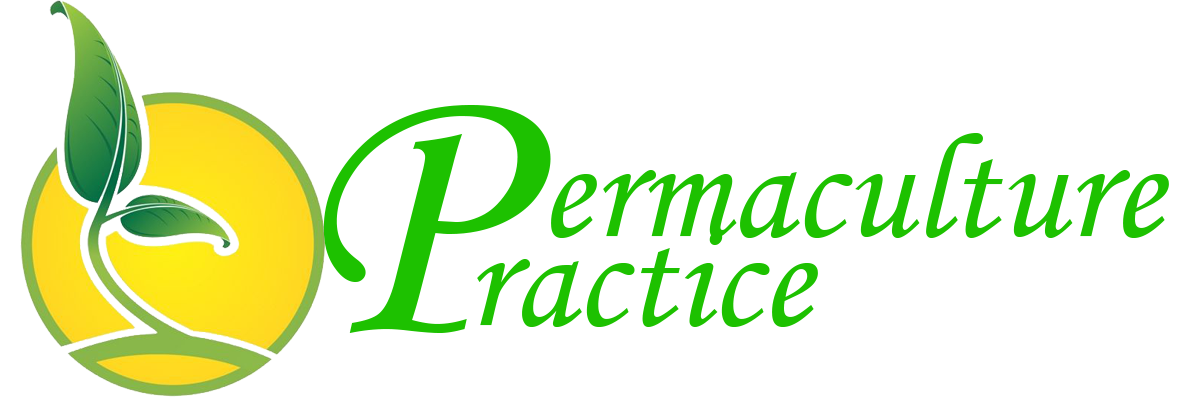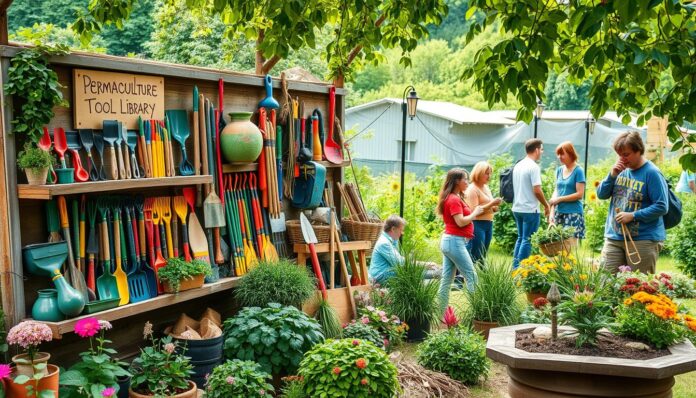I love gardening and care about the planet. Permaculture’s idea of natural systems has always drawn me in. But, getting the tools needed for permaculture projects can be expensive. That’s why a tool-lending library caught my eye. It’s a way to help our community live more sustainably without wasting resources.
Imagine a place where everyone can share tools and learn together. It’s a spot where buying special tools isn’t a problem. This idea is at the heart of a permaculture tool-lending library. It’s a place of knowledge, teamwork, and empowerment.
Key Takeaways
- Starting a permaculture tool-lending library can help our community live more sustainably.
- It makes permaculture more affordable, so more people can try it out.
- Sharing tools and knowledge builds stronger community bonds and encourages learning together.
- Keeping the library stocked and organized takes planning and effort.
- Getting the word out and engaging with the community can grow its impact.
Understanding Permaculture and Its Benefits
Permaculture is a way of living that focuses on making systems better. It uses many methods like hydroponics and organic farming. The goal is to make farming systems that are good for the environment and don’t waste resources.
What is Permaculture?
Permaculture started in the 1970s by Bill Mollison and David Holmgren. They wanted a way to live that was better for the planet. Today, it has 12 main principles that focus on caring for people, the earth, and sharing fairly.
Key Principles of Permaculture
Permaculture is all about not wasting anything and working together. It values using renewable resources and finding creative solutions. These ideas help reduce harm to the environment and make living more sustainable.
Environmental and Community Advantages
Living in a permaculture community has many benefits. It helps keep wildlife safe, grows organic food, and improves health. It also helps manage waste and water in cities and reduces energy use. As more people learn about it, permaculture is becoming a key part of sustainable living.
| Permaculture Principles | Zero Waste Principles |
|---|---|
| Produce no waste | Circular economy |
| Design from patterns to details | Renewable resources and services |
| Integrate community building | Small and slow solutions |
| Emphasize creativity and responding to change | Encourage creativity and change |
The table shows how permaculture and zero waste share common goals. Both aim for a circular economy and use renewable resources. They also focus on community solutions to environmental problems.
“Permaculture is a philosophy of working with, rather than against nature; of protracted and thoughtful observation rather than protracted and thoughtless labor; and of looking at plants and animals in all their functions, rather than treating any area as a single-product system.” – Bill Mollison
The Concept of a Tool-Lending Library
Tool-lending libraries are a new way for communities to share tools. They offer a variety of tools, from gardening to home improvement, for a short time. This idea saves money and helps the environment by reducing waste.
Definition and Purpose
A tool-lending library is like a public library but for tools. It lets people borrow tools they can’t afford or don’t use often. This way, everyone can use tools without having to buy them all.
Benefits of Tool-Lending Libraries
Tool-lending libraries have many benefits. They help people save money and reduce waste. They also bring communities together and encourage green living, like organic farming methods and water conservation strategies.
Examples from Existing Libraries
In the United States, many cities have tool-lending libraries. For example, the Berkeley Tool Lending Library in California has over 4,000 tools. The 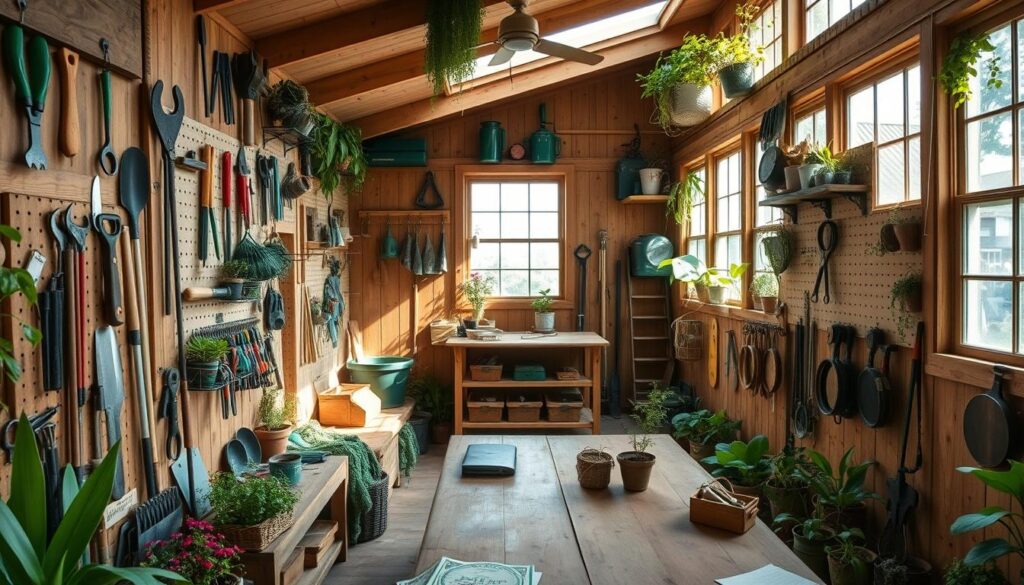 in Seattle, Washington, also has a wide range of tools for various projects. These libraries are places where people come together and support sustainable living.
in Seattle, Washington, also has a wide range of tools for various projects. These libraries are places where people come together and support sustainable living.
Assessing Community Needs
To start a successful tool-lending library, you need to know what your community wants. Surveys and talks with local gardening groups can give you the insights you need. These will help shape your library’s success.
Conducting a Community Survey
First, make a detailed survey to learn about your community’s tool needs. This will show you which tools are most used in gardening and sustainability. A good survey can also reveal ways to improve environmental stewardship and community resilience through your library.
Identifying Commonly Used Tools
After the survey, list the tools your community uses the most. This will help you choose the right tools for your library. By focusing on what’s in demand, you’ll make your library more useful.
Engaging Local Gardening Groups
Connect with local gardening clubs and community gardens to learn more about their needs. They can share their tool preferences and ideas for workshops or events. Building these partnerships will help strengthen community resilience and environmental stewardship.
Selecting Tools for Your Library
Starting your zero-waste permaculture tool-lending library is exciting. Choosing the right tools is key. Look for tools that are durable, versatile, and fit sustainable gardening and permaculture. You’ll need a mix of hand tools, power tools, and special equipment for your community’s projects.
Criteria for Tool Selection
Choose tools that last long and can do many tasks. They should follow permaculture’s principles. Opt for tools made from strong materials that can handle frequent use. Tools that can do more than one thing, like multi-head rakes, are great picks.
Types of Tools to Include
Your library should have a wide range of tools for different permaculture tasks. Include basic gardening tools like shovels, hoes, trowels, and pruners. Add power tools like chainsaws, hedge trimmers, and tillers for bigger jobs. Don’t forget tools for composting, saving water, and controlling pests.
Sourcing Your Tools
Find tools in ways that support your zero-waste goals. Ask for donations from local businesses and community members. Work with eco-friendly makers to reduce environmental harm.
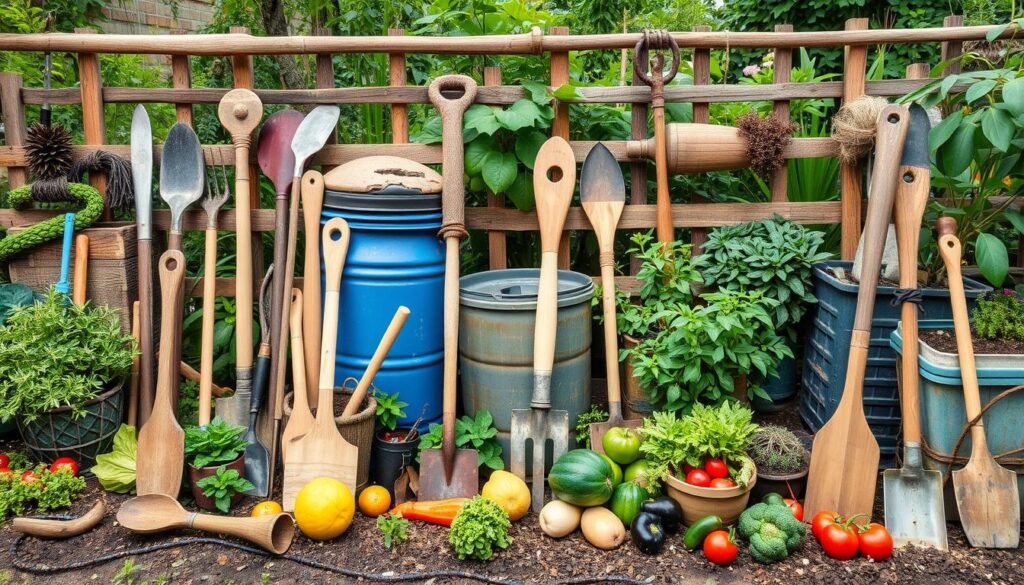
By picking and getting tools wisely, you’ll build a library that helps your community. It will support them in facing zero-waste challenges and living sustainably.
Establishing a Space for Your Library
Choosing the right spot for your eco-friendly gardening tool-lending library is key. A good location makes it easy to find and use, encouraging more people to join in. Pick a spot that’s in the middle of things, where lots of people go by.
Choosing the Right Location
Find a place that’s easy to get to by public transport and has plenty of parking. Being near parks, schools, or libraries is a plus. This way, your library becomes a part of the community, helping everyone.
Designing Your Tool Storage Area
After finding the perfect spot, think about how to store your tools. Use smart shelving and pegboards to save space. Make sure everything is labeled and organized, so people can easily find what they need.
Ensuring Accessibility for All
Being open to everyone is important for your library’s success. Make sure it’s easy for people of all abilities to use. Add ramps, wide paths, and adjustable shelves to help everyone. This shows you care about making your community a welcoming place for all.
“Permaculture is the conscious design and maintenance of agriculturally productive ecosystems which have the diversity, stability, and resilience of natural ecosystems.” – Bill Mollison, co-founder of permaculture
Creating a Membership Structure
Creating a good membership structure is key for your environmental stewardship tool-lending library. Offer different membership levels to make it accessible for everyone. Use a sliding scale for fees so people can pay what they can afford.
This way, you support sustainable living and build a community feeling. It makes everyone feel like they own a part of the library.
Think about other ways to get the community involved. Let members help decide what the library does. This makes them feel powerful and responsible for the library’s success.
Also, offer chances for members to volunteer. They can help out and get discounts or free membership. This helps the library and the community grow together.
Designing a good membership structure makes your library strong and connected to the community. It becomes a place for sustainable living and learning about the environment.
Developing a Check-Out System
Creating a permaculture tool-lending library needs a good check-out system. This system should follow zero-waste principles. You can choose between paper-based and digital systems to reduce waste and make borrowing easier.
It’s also key to track tool use and manage inventory well. This ensures your library stays sustainable and useful for everyone.
Traditional vs. Digital Systems
Paper-based systems work but use more resources like paper and pens. This leads to more waste. On the other hand, digital systems use less paper and are better for the environment.
Zero-waste permaculture challenges can be met with digital solutions.
Tracking Tool Usage and Inventory
Choosing a check-out system, you must track tool use and inventory. This helps keep tools in good shape and shows what tools are needed. It also helps understand how the community uses the tools.
Establishing Clear Borrowing Guidelines
Clear borrowing guidelines are crucial for responsible tool use and timely returns. These guidelines should cover loan periods, renewals, late fees, and what to do with lost or damaged tools. This helps everyone feel responsible and promotes the program’s sustainability.
| Criteria | Traditional System | Digital System |
|---|---|---|
| Resource Consumption | Higher (paper, pens, filing) | Lower (electronic records) |
| Inventory Tracking | Manual, labor-intensive | Automated, efficient |
| Borrower Accountability | Relies on physical signatures | Leverages digital authentication |
| Accessibility | Limited to physical location | Remote access capabilities |
By weighing the pros and cons of traditional and digital systems, and setting clear guidelines, your tool-lending library can help with zero-waste permaculture challenges. It also builds community resilience in your area.
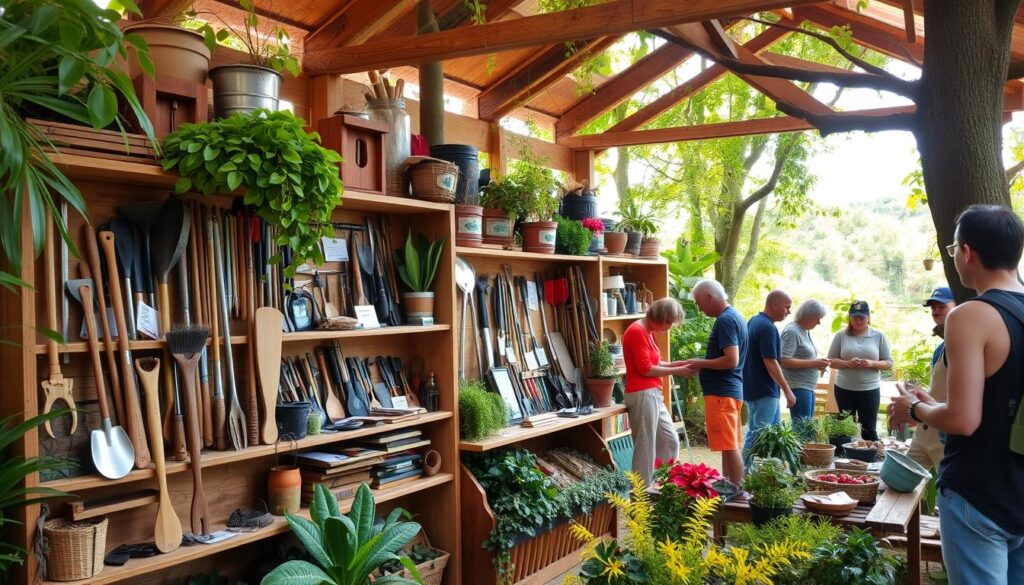
Promoting Your Tool-Lending Library
“If you build it, they will come.” But for a tool-lending library, you need to reach out to your community. Use smart ways to promote your library. This will draw in gardeners and environmental lovers, making your community strong and active.
Strategies for Community Outreach
Reaching out to your community is key. Work with local gardening clubs, green groups, and community centers. Host workshops or demos on green gardening, showing off your tools and encouraging people to join.
Utilizing Social Media Platforms
Social media is a big help in promoting your library. Use Facebook, Instagram, and Twitter to share news, tips, and stories. Ask your members to share their experiences and talk to your online followers. Use hashtags like #ecogardeningtools and #environmentalstewardship to reach more people.
Hosting Community Events
Events are great for promoting your library and getting new members. Host workshops on tool care and maintenance. Or, organize permaculture workshops and garden tours to show your library’s impact. These events educate and build a sense of community and shared responsibility for the environment.
By using many ways to reach out, you can grow your library’s community. Work with partners, engage on social media, and host events. This way, your library becomes a key place for sustainable living and caring for the environment in your area.
Building Partnerships with Local Organizations
It’s key to team up with local groups to grow your tool-lending library. Working with different community members can help you reach more people. This way, you can make a bigger difference in living sustainably and building stronger communities.
Connecting with Local Businesses
Get in touch with local shops, hardware stores, and gardening spots. They might give you tools, offer deals, or support your library. These partnerships bring in important tools and show everyone is working together for success.
Collaborating with Nonprofits
Look for local groups that care about the environment and helping communities. They can help spread the word about your library, plan events together, or even give money. Working with these groups can make your efforts even stronger.
Leveraging Local Schools and Community Centers
Work with schools, community centers, and places of learning to add your library to their programs. This helps you reach more people, teach them about tools, and give them hands-on learning. It’s a great way to teach sustainable living.
| Organization | Partnership Opportunity | Potential Impact |
|---|---|---|
| Town and City Permaculture | Tool donations, workshops, and joint events | Increased awareness and community engagement in sustainable living |
| Acta Non Verba | Educational programs and youth engagement | Nurturing the next generation of sustainable living advocates |
| Phat Beets | Collaboration on urban gardening and farming initiatives | Strengthening community resilience through food production |
| Castlemont Farm and Gardens | Integration of tool-lending into school curriculum | Embedding sustainable living practices into education |
By teaming up with local groups, your tool-lending library can become a key spot for sustainable living and community resilience. This will help your library grow and succeed for a long time.
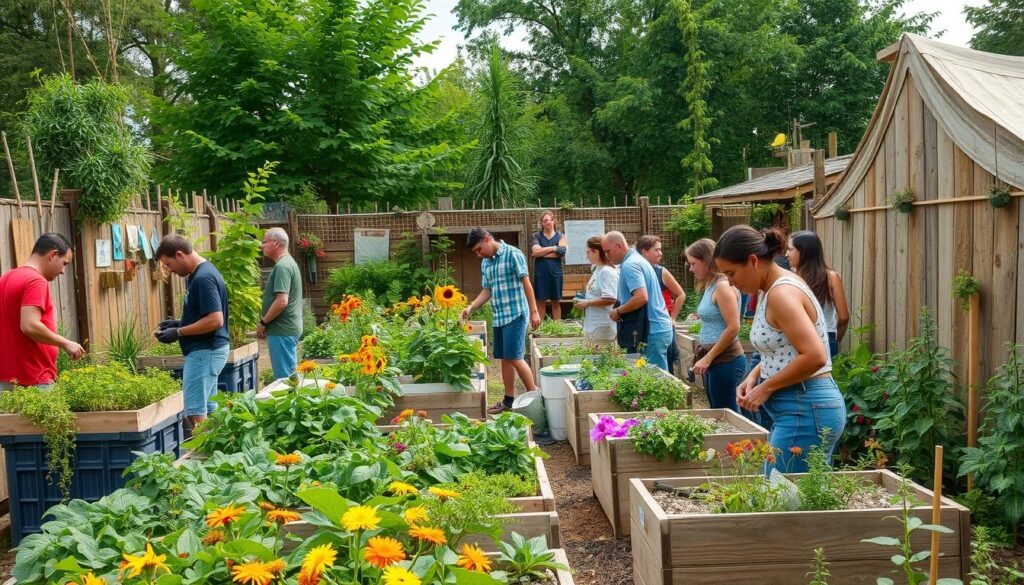
Maintaining Your Tool Library
Keeping a tool library well-stocked and functional is key in eco-friendly gardening and zero-waste permaculture. It ensures tools last long and keeps gardening safe and efficient for everyone.
Regularly Inspecting Tools
Checking tools regularly is essential for tool library upkeep. Look at each tool’s condition, from blade sharpness to handle strength. This helps catch problems early and keeps everyone safe while gardening.
Creating a Maintenance Schedule
Having a detailed maintenance plan is vital for your tool library’s success. Set times for cleaning, sharpening, and fixing tools. Use volunteers or local shops for help. This keeps your tools ready for gardening and permaculture projects.
Handling Repairs and Replacements
Tools will need repairs or new ones eventually. Make clear plans for these situations, including who to call for repairs and how to budget for new tools. Choose durable, eco-friendly tools to support your community’s gardening goals.
| Tool Maintenance Practices | Frequency |
|---|---|
| Cleaning and Inspection | Weekly |
| Sharpening Blades | Monthly |
| Minor Repairs | Bi-weekly |
| Tool Replacements | Annually |
A strong maintenance system keeps your tool library supporting gardening and permaculture. It ensures your tools are safe and last a long time.
Educating Members on Tool Use
A successful tool-lending library focuses on teaching its members. It offers workshops, resources, and one-on-one training. This way, your library becomes a place where people learn and grow together. They gain knowledge in organic farming and saving water.
Organizing Workshops and Demonstrations
Workshops and demonstrations are key to engaging your members. They learn how to use the tools and apply permaculture in gardening and saving water. These sessions are hands-on and cover a lot of topics.
Providing Resource Materials
Offer a wide range of resources like guides, videos, and brochures. These are available at your library and online. This way, members can learn whenever they want and refer back to the information.
Offering One-on-One Training Sessions
For extra help, offer one-on-one training. These sessions focus on specific tools and projects. They also help with using organic farming and saving water in gardening or farming.
With a strong educational program, your library empowers your community. It makes them more self-sufficient and environmentally aware. Learning and sharing knowledge not only helps your tools last longer but also strengthens your local ecosystem.
Evaluating and Expanding Your Library
To keep your tool-lending library thriving, you must always look for ways to improve. Ask your members for feedback through surveys and focus groups. This helps you understand what they need from your library.
Look at how often tools are used to guide your choices. See which permaculture practices your members enjoy the most. This helps you make better decisions about what tools to add.
Plan for your library’s future growth. You might want to add more tools for different permaculture techniques. Or, you could improve your educational programs to support environmental stewardship even more.
Think about sharing your library model with other communities. This could help spread the idea of community resilience and environmental care. Your library can be a key player in creating a greener, more resilient future.
